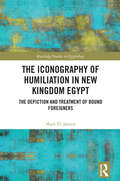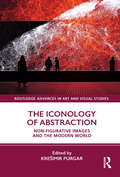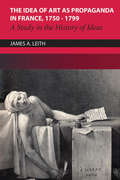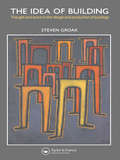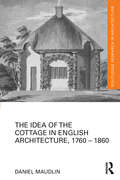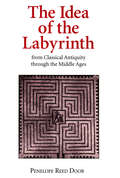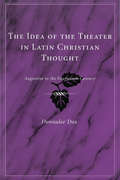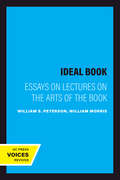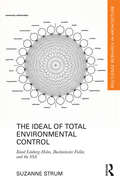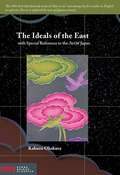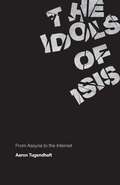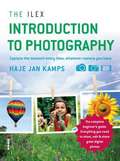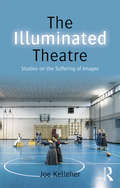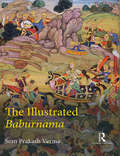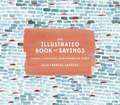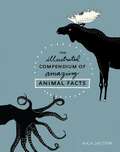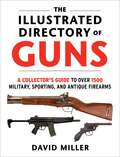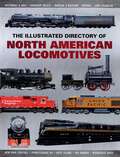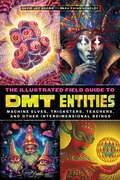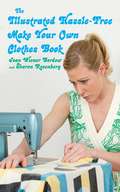- Table View
- List View
The Iconography of Humiliation in New Kingdom Egypt: The Depiction and Treatment of Bound Foreigners (Routledge Studies in Egyptology)
by Mark D. JanzenThis volume analyzes the iconography of bound foreigners on New Kingdom monuments and artifacts to better understand Egyptian perspectives on foreigners and their treatment of prisoners of war.Depictions of foreign captives in humiliating or torturous poses are ubiquitous in Egyptian iconography and reflect the celebratory nature of royal ideology, in this case by degrading enemies. Egyptologists have scrutinized these scenes for details regarding various military matters, but existing scholarly literature offers few studies focused on enemy captives and the sheer physical brutality of the depictions of their bindings. Janzen examines the bound foreigner motif in New Kingdom sources, demonstrating that these prisoners of war played vital roles in Egyptian ideology and religion. Their depictions in bizarre or torturous poses served to reinforce ideological underpinnings of pharaoh’s right to rule, perpetually ritualizing their defeat and/or punishment through the presence of this iconography on ceremonial objects used primarily by the king and on temple walls and monuments. The subjugation of foreigners also constituted an important economic function, as incorporating prisoners of war into the Egyptian workforce was crucial for economic prosperity and growth in New Kingdom Egypt. The volume also explores cross-cultural and anthropological parallels, placing Egyptian treatment of foreign prisoners in its ancient context.The book provides a fascinating study of the subject suitable for scholars and students of Egyptology and ancient history, particularly that of New Kingdom Egypt, as well as those working on power, warfare, and violence in the ancient world more broadly.
The Iconology of Abstraction: Non-figurative Images and the Modern World (Routledge Advances in Art and Visual Studies)
by Krešimir PurgarThis book uncovers how we make meaning of abstraction, both historically and in present times, and examines abstract images as a visual language. The contributors demonstrate that abstraction is not primarily an artistic phenomenon, but rather arises from human beings’ desire to imagine, understand and communicate complex, ineffable concepts in fields ranging from fine art and philosophy to technologies of data visualization, from cartography and medicine to astronomy. The book will be of interest to scholars working in image studies, visual studies, art history, philosophy and aesthetics.
The Idea Agent: The Handbook on Creative Processes
by Jonas Michanek Andréas BreilerThe Idea Agent is a practical idea management handbook, aimed at people who want to take an active role in creative processes across all areas. It combines the creatively wild with the rationally structured techniques for innovation to provide readers with a varied toolbox of proven idea management methodology. From discussing how to identify a problem or opportunity, to describing techniques for idea creation, it offers a step-by-step guide to building creative concepts for the marketplace. With built-in exercises and applications, this book is an ideal working companion for any innovator.
The Idea of Art as Propaganda in France, 1750-1799: A Study in the History of Ideas (The Royal Society of Canada Special Publications #No. 8)
by James LeithOne of the most modern features of the French Revolution was its intention of shaping a new kind of citizen by exposing him from childhood to inspirational messages and behavioral models. In this effort to regenerate the masses the French Revolutionaries sought to employ not only schools, but newspapers, festivals, dramas, poems, songs, paintings, statues, and engravings as well. At the peak of the Terror, French leaders brough tthe West to the threshold of the totalitarian state in the fullest sense of the world: they established a single party state, directed a regimented economy, created a mass army, and sought to mobilize all the media capable of influencing the human mind. In was an interest in both art and the Revolution which led Professor Leith to explore the groth of the idea of using art as one instrument of propaganda. The idea proved to have deep roots in western civilization, going back to classical thinkers, medieval churchmen, and the art officials of such monarchs as Louis XIV. But following the hedonistic rococo art of the first half of the eighteenth century, this idea of didactic art took on a new lease of life, reaching a crescendo during the Terror. This book analyses the contribution of the philosophes, the Encyclopedists, royal officials, art critics, and revolutionary leaders to the resurgence of the idea; it also probes the peculiar psychological assumptions which led eighteeneth-century thinkers to believe in the efficacy of visual propaganda. The outcome of this idea of art as an ideological weapon was involved in the fate of the Revolution itself, yet it was also affected by certain curious tensions already evident in the minds of its advocates under the Old Régime. Lingering interest in purely aesthetic values,k affirmation of the need for creative freedom, and determination to maintain French cultural hegemony, all complicated the effort to turn art into a vehicle of civic instruction. The final chapter examines the rôle of these tensions in the dénouement of the idea in the closing phase of the Revolution.This book should appeal not only to those interested in French civilization, the age of Enlightment, and they French Revolution, but to those concerned with the rôle of art and the artist in modern society as well.
The Idea of Audience: Artists and the Task of Audience Development in the Era of Creative Industries
by Simon PieningWhat sort of relationship do artists want with their audience? What kind of role do they imagine for the performing arts in their community?Under the “creative industries”, the audience relationship has been increasingly defined and shaped by marketing and/or institutional interests. Wedged between the competing needs of the market, and their belief in the power of art to positively impact their communities, many artists and arts workers are caught in what Julian Meyrick describes as a “confused intellectual terrain”. While much audience scholarship has focused on understanding the motivations of audience members engaging with the arts, there has been considerably less research into the motivations of arts professionals with respect to their relationship with the audience. The Idea of Audience is a critical examination of the current fields of audience development and arts marketing, and explores the relationship between artists and audiences from the perspective of the artists themselves.The book will be of most interest to students and academics of audience development/arts marketing, theatre/performance, and audience studies. It is hoped that the reader will gain greater insight into what artists actually mean when they talk about their audience.
The Idea of Building: Thought and Action in the Design and Production of Buildings
by Steven GroakThis book is unique in its attempt to explore the many ways we have of thinking about buildings. In particular it raises questions about the kinds of knowledge we have and will need in designing, making and enjoying our buildings. At the very least this book provides an overview of the fragmented construction industry, making it a vital purchase for all construction related students. However, the author has written for a wider audience making the book an essential guide for those interested in the form of buildings or the deliberate ways in which people build them.
The Idea of Nature in Disney Animation: From Snow White to WALL-E (Studies in Childhood, 1700 to the Present)
by David WhitleyIn the second edition of The Idea of Nature in Disney Animation, David Whitley updates his 2008 book to reflect recent developments in Disney and Disney-Pixar animation such as the apocalyptic tale of earth's failed ecosystem, WALL-E. As Whitley has shown, and Disney's newest films continue to demonstrate, the messages animated films convey about the natural world are of crucial importance to their child viewers. Beginning with Snow White, Whitley examines a wide range of Disney's feature animations, in which images of wild nature are central to the narrative. He challenges the notion that the sentimentality of the Disney aesthetic, an oft-criticized aspect of such films as Bambi, The Jungle Book, Pocahontas, Beauty and the Beast, and Finding Nemo, necessarily prevents audiences from developing a critical awareness of contested environmental issues. On the contrary, even as the films communicate the central ideologies of the times in which they were produced, they also express the ambiguities and tensions that underlie these dominant values. In distinguishing among the effects produced by each film and revealing the diverse ways in which images of nature are mediated, Whitley urges us towards a more complex interpretation of the classic Disney canon and makes an important contribution to our understanding of the role popular art plays in shaping the emotions and ideas that are central to contemporary experience.
The Idea of the Cottage in English Architecture, 1760 - 1860 (Routledge Research in Architecture)
by Daniel MaudlinThe Idea of the Cottage in English Architecture is a history of the late Georgian phenomenon of the architect-designed cottage and the architectural discourse that articulated it. It is a study of small buildings built on country estates, and not so small buildings built in picturesque rural settings, resort towns and suburban developments. At the heart of the English idea of the cottage is the Classical notion of retreat from the city to the countryside. This idea was adopted and adapted by the Augustan-infused culture of eighteenth-century England where it gained popularity with writers, artists, architects and their wealthy patrons who from the later eighteenth century commissioned retreats, gate-lodges, estate workers' housing and seaside villas designed to 'appear as cottages'. The enthusiasm for cottages within polite society did not last. By the mid-nineteenth century, cottage-related building and book publishing had slowed and the idea of the cottage itself was eventually lost beneath the Tudor barge-boards and decorative chimneystacks of the Historic Revival. And yet while both designer and consumer have changed over time, the idea of the cottage as the ideal rural retreat continues to resonate through English architecture and English culture.
The Idea of the Labyrinth from Classical Antiquity through the Middle Ages
by Penelope Reed DoobAncient and medieval labyrinths embody paradox, according to Penelope Reed Doob. Their structure allows a double perspective—the baffling, fragmented prospect confronting the maze-treader within, and the comprehensive vision available to those without. Mazes simultaneously assert order and chaos, artistry and confusion, articulated clarity and bewildering complexity, perfected pattern and hesitant process. In this handsomely illustrated book, Doob reconstructs from a variety of literary and visual sources the idea of the labyrinth from the classical period through the Middle Ages.Doob first examines several complementary traditions of the maze topos, showing how ancient historical and geographical writings generate metaphors in which the labyrinth signifies admirable complexity, while poetic texts tend to suggest that the labyrinth is a sign of moral duplicity. She then describes two common models of the labyrinth and explores their formal implications: the unicursal model, with no false turnings, found almost universally in the visual arts; and the multicursal model, with blind alleys and dead ends, characteristic of literary texts. This paradigmatic clash between the labyrinths of art and of literature becomes a key to the metaphorical potential of the maze, as Doob's examination of a vast array of materials from the classical period through the Middle Ages suggests. She concludes with linked readings of four "labyrinths of words": Virgil's Aeneid, Boethius' Consolation of Philosophy, Dante's Divine Comedy, and Chaucer's House of Fame, each of which plays with and transforms received ideas of the labyrinth as well as reflecting and responding to aspects of the texts that influenced it.Doob not only provides fresh theoretical and historical perspectives on the labyrinth tradition, but also portrays a complex medieval aesthetic that helps us to approach structurally elaborate early works. Readers in such fields as Classical literature, Medieval Studies, Renaissance Studies, comparative literature, literary theory, art history, and intellectual history will welcome this wide-ranging and illuminating book.
The Idea of the Theater in Latin Christian Thought: Augustine to the Fourteenth Century
by Donnalee DoxMedieval thinkers did not construe drama as theatrical performances, Dox (performance studies, Texas A&M U. ) argues, because of how thought was organized beginning with the late classical transmitters and through the Scholastics. Theater as a performance practice and institutional institution was distinguished from poetry, rhetoric, reading, and writing until the height of the Scholastic period, early in the 14th century, when this categorical distinction began to break down. She says her conclusions complement rather than challenge others derived from the same material. Annotation ©2004 Book News, Inc. , Portland, OR (booknews. com)
The Ideal Book: Essays on Lectures on the Arts of the Book
by William MorrisThis title is part of UC Press's Voices Revived program, which commemorates University of California Press’s mission to seek out and cultivate the brightest minds and give them voice, reach, and impact. Drawing on a backlist dating to 1893, Voices Revived makes high-quality, peer-reviewed scholarship accessible once again using print-on-demand technology. This title was originally published in 1982.
The Ideal of Total Environmental Control: Knud Lönberg-Holm, Buckminster Fuller, and the SSA (Routledge Research in Architecture)
by Suzanne StrumThis book traces the ideal of total environmental control through the intellectual and geographic journey of Knud Lönberg- Holm, a forgotten Danish architect who promoted a unique systemic, cybernetic, and ecological vision of architecture in the 1930s. A pioneering figure of the new objectivity and international constructivism in Germany in 1922 and a celebrated peer of radical figures in De Stijl, the Bauhaus, and Russian constructivism, when he emigrated to Detroit in 1923 he introduced the vanguard theory of productivism through his photography, essays, designs, and pedagogy. By following Lönberg- Holm’s ongoing matrix of relations until the postwar era with the European vanguards in CIAM and former members of the Structural Study Associates (SSA), especially Fuller, Frederick Kiesler, and C. Theodore Larson, this study shows how their definition of building as a form of environmental control anticipated the contemporary disciplines of industrial ecology, industrial metabolism, and energy accounting.
The Ideals of the East
by Kakuzo OkakuraThe 1904 book that famously declared "Asia is one" was among the first studies in English to reference Zen as it explored the roots of Japanese beauty. Like the author's The Book of Tea, this volume emphasized the spiritual ideals of Asian, and especially Japanese, art. Kakuzo Okakura (1863-1913) was an administrator and scholar whose writings helped shape the West's early views of Japan and Asia.
The Idols of ISIS: From Assyria to the Internet
by Aaron TugendhaftIn 2015, the Islamic State released a video of men smashing sculptures in Iraq’s Mosul Museum as part of a mission to cleanse the world of idolatry. This book unpacks three key facets of that event: the status and power of images, the political importance of museums, and the efficacy of videos in furthering an ideological agenda through the internet. Beginning with the Islamic State’s claim that the smashed objects were idols of the “age of ignorance,” Aaron Tugendhaft questions whether there can be any political life without idolatry. He then explores the various roles Mesopotamian sculpture has played in European imperial competition, the development of artistic modernism, and the formation of Iraqi national identity, showing how this history reverberates in the choice of the Mosul Museum as performance stage. Finally, he compares the Islamic State’s production of images to the ways in which images circulated in ancient Assyria and asks how digitization has transformed politics in the age of social media. An elegant and accessibly written introduction to the complexities of such events, The Idols of ISIS is ideal for students and readers seeking a richer cultural perspective than the media usually provides.
The Ilex Introduction to Photography: Capturing the moment every time, whatever camera you have
by Haje Jan Kamps the Ilex TeamBy understanding the basics of how your camera works, and the few simple rules that make photos work, you’ll soon find your own pictures filling with life, colour, energy, and character. <P><P> Over the course of a decade, the Ilex Photo team has won a deserved reputation as a world-beating publisher of practical titles for photographers. Written in collaboration with top-ranking photographer-blogger, Haje Jan Kamps, The Ilex Introduction to Photography is the definitive first book for owners of all cameras. <P> The book introduces the basics of how today’s digital cameras work, and the principles of good photography (light, colour and composition) before looking at common shooting situations (pets, family, food, B&W, architecture...) and offering practical and inventive solutions to them. <P> Contains straightforward advice on what to look out for when choosing your camera, how to master photography fundamentals and discover the tricks and techniques to ensure every photo is memorable and includes a dedicated chapter covering popular subjects that’s packed with tips to help you shoot in any situation you can think of.
The Illuminated Theatre: Studies on the Suffering of Images
by Joe KelleherWhat sort of thing is a theatre image? How is it produced and consumed? Who is responsible for the images? Why do the images stay with us when the performance is over? How do we learn to speak of what we see and imagine? And how do we relate what we experience in the theatre to what we share with each other of the world? The Illuminated Theatre is a book about theatricality and spectatorship in the early twenty-first century. In a wide-ranging analysis that draws upon theatrical, visual and philosophical approaches, it asks how spectators and audiences negotiate the complexities and challenges of contemporary experimental performance arts. It is also a book about how European practitioners working across a range of forms, from theatre and performance to dance, opera, film and visual arts, use images to address the complexities of the times in which their work takes place. Through detailed and impassioned accounts of works by artists such as Dickie Beau, Wendy Houstoun, Alvis Hermanis and Romeo Castellucci, along with close readings of experimental theoretical and art writing from Gillian Rose to T.J. Clark and Marie-José Mondzain, the book outlines the historical, aesthetic and political dimensions of a contemporary ‘suffering of images.’
The Illustrated Baburnama
by Som Prakash VermaThis book presents the Persian Baburnama, a key primary source and the earliest record of Babur’s memoirs. The authoritative translation uses paintings from the original work and draws on contemporary texts of the period to delve into the history of the legendary Mughal ruler. It provides a fresh treatment to the source material and highlights vivid accounts of the historical events of the time. The paintings are divided thematically, offering a unique and rare perspective into the Mughal world. Accompanied by a detailed Introduction, the volume also touches upon narrative art and analyses the influence of European Renaissance art on Mughal painting. With over 150 Mughal paintings and illustrations in colour, this volume will be an important sourcebook for scholars and researchers of Medieval Indian, especially Mughal, history, and art historians, as well as connoisseurs of art and the general reader.
The Illustrated Book of Sayings: Curious Expressions from Around the World
by Ella Frances SandersFrom the New York Times bestselling author of Lost in Translation comes this charming illustrated collection of more than fifty expressions from around the globe that explore the nuances of language. From the hilarious and romantic to the philosophical and literal, the idioms, proverbs, and adages in The Illustrated Book of Sayings reveal the remarkable diversity, humor, and poignancy of the world's languages and cultures.From the Hardcover edition.
The Illustrated Catalog of Rifles and Shotguns: 500 Historical to Modern Long-Barreled Firearms
by David MillerA complete compendium of rifles and shotguns through the ages. A "rifled" firearm is one in which the projectile is made to spin as it travels up the bore. The term "rifle," however, was originally applied to muskets to differentiate them from the earlier smoothbore weapons and is used today to designate the infantryman's personal weapon, fired from the shoulder or the hip, or, in some modern weapons, from a bipod. The rifle has also been used by sportsmen to kill larger game and was also used as a working tool by cowboys and trappers during the period of Western Expansion. It progressed from being a muzzle-loader to a breechloading, bolt-operated weapon, then to a semi-automatic weapon, and finally to a lightweight "assault rifle." The emphasis throughout these developments has been in increasing the rate of fire, reducing the weight and making the weapons more accurate, simpler to fire, more reliable, and easier to maintain. The shotgun is a smoothbore weapon originally developed as a hunting device for killing fast moving, flying or running prey. Loaded with shot (many small projectiles) the chances of hitting a moving target was greatly enhanced. Like the rifle, the shotgun has undergone similar progression from muzzle-loader to breechloader, bolt action, and finally semi-automatic mode. The weapon has also seen military use in trench warfare and special operations as well as riot suppression by the police. The Illustrated Catalog of Rifles and Shotguns shows the reader over 500 longarms of all types form the early flintlocks of the revolutionary period, the percussion cap rifles and repeaters of the Civil War, the famous rifles and shotguns of the Wild West, the standard infantry rifles of two World Wars, to the present day with Assault Rifles, and combat shotguns, together with state-of-the-art sporting rifles and shotguns. Each entry has a color photo along with a description and a technical specification. It is arranged in alphabetical order within five historical periods: Historic, Civil War, The Frontier, Two World Wars, and Modern, plus a separate comprehensive Shotgun section.
The Illustrated Compendium of Amazing Animal Facts
by Maja SäfströmNew York Times bestseller • An artfully playful collection of unexpected and remarkable facts about animals, illustrated by Swedish artist Maja Säfström. Did you know that an octopus has three hearts? Or that ostriches can't walk backward? Or that a group of owls is called a parliament, or that they have three eyelids?Sea otters hold hands in their sleep, bees never sleep, and penguins laugh when they're tickled!This charming compendium contains over 100 pages of fascinating facts about the animal kingdom illustrated with whimsical detail.
The Illustrated Directory of Guns: A Collector's Guide to Over 1500 Military, Sporting, and Antique Firearms
by David MillerWritten by a technical expert who has fired many of the guns featured, this book includes wide and varied assemblage of weapons from each of the world&’s major manufacturing countries.The Illustrated Directory series provide readers with a fully illustrated, comprehensive reference book packed with timelines, historical facts, and images designed to inform and excite. At 512 pages packed with information and photographs, this book is a necessary addition to any enthusiast's library. Complete with full specification table with each entry including type, origin, caliber, and size, The Illustrated Directory of Guns is the most ambitious and lavishly illustrated history of guns for the collector and enthusiast. It shows in clear, detailed photographs and text over 1500 guns with separate sections on Pistols, Revolvers, Rifles, Shotguns (military and sporting), Machine Guns, and Submachine guns. A few featured include:RemingtonSmith & WessonWinchesterGlockVickersMauserBrowningColtBerettaAnd more Organized A-Z by country and gunmaker's name, the book clearly shows the different types of gun which the world has used to hunt, wage war, break and defend its laws, hone its sharpshooting skills, and fire purely for the fun of it. The book also features an introduction on each section, which gives a brief history of the development of that particular kind of firearm.
The Illustrated Directory of North American Locomotives: The Story and Progression of Railroads from The Early Days to The Electric Powered Present
by Pepperbox PressMore than 250 classic American locomotives."Let the country but make the railroads, and the railroads will make the country." — Edward PeaseDuring the mid-1800s, American railroads became the lifeblood of new communities in the West and brought new ways of life and means of commerce to rural communities. Railroads became the shining thread that tied together the tapestry of American life into a land of plenty. The Illustrated Dictionary of North American Locomotives explores the story of railroads and their motive power. Giant beasts of iron and steel once roamed the land. Their descendants still race across the country.This book charts the progress of motive power on America's railroads from 1830 until the present. Its 432 pages illustrate a wide variety of grand and humble locomotives from the steam powered Puffing Billy types of the "Early Days" chapter, to the mighty Allegheny class steamers that were used to haul coal for the American industry in the "Steam in Charge" chapter. Technical specifications are given for each engine type and the book is fully illustrated with both black & white and color photos. The book goes on to show the progress of Diesel Power, including the output of General Electric and General Motors electromotive division (EMD) from the 1920s to the present. Ultimately, the book also explores the Electric Power that powers so many of today's railways.
The Illustrated Field Guide to DMT Entities: Machine Elves, Tricksters, Teachers, and Other Interdimensional Beings
by David Jay Brown Sara Phinn Huntley• Examines 25 of the most commonly encountered DMT entities, from machine elves and fairies to insectoids, Reptilians, and divine beings such as Grandmother Ayahuasca• Discusses each entity in depth, including people&’s encounters with them from trip reports and scientific studies, descriptions of how the entities appear and behave, and communications or teachings they impart• Features visionary art by Sara Phinn Huntley and other artists, including Alex Grey, Andrew Jones, Luke Brown, Juliana Garces, Erial Ali, and Harry PackOne of the features consistently noted by visitors to the hyperspace realm invoked by DMT is the existence of many different entities. In this full-color illustrated handbook for understanding the intelligent alien species of hyperspace, psychedelic explorer David Jay Brown and visionary artist Sara Phinn Huntley explore 25 of the most commonly encountered DMT beings and ayahuasca spirits, from &“self-transforming machine elves,&” ancestor spirits, tricksters, and metallic spheres to insectoid mantis beings, reptilians, gray aliens, nature spirits, and divine beings, such as the Virgin Mary, Gaia, angels, Grandmother Ayahuasca, and deities from Hindu, Egyptian, and South American spiritual traditions.Profiling the DMT entities in the style of a naturalistic field guide, complete with evocative illustrations by Huntley and other artists such as Alex Grey, Andrew Jones, Luke Brown, Juliana Garces, Erial Ali, and Harry Pack, the authors discuss the entities in depth, including people&’s encounters with them, descriptions of how they appear, and summaries of the communications they impart. They explore whether these beings are generated by our minds or if they exist independently of the DMT trip.Providing a comprehensive exploration of this world, this guide seeks to describe the alien residents of interdimensional space and help people who have encountered DMT beings integrate their experiences.
The Illustrated Hassle-Free Make Your Own Clothes Book
by Sharon Rosenberg Joan Wiener BordowHere is the straight-up dope on how to make your own clothing. With or without patterns, machines, or fancy materials--anyone can do it! Got some old clothes that you love and that fit well? Use them as patterns for new ones. Want something new and spectacular, something that fits right along where your head is moving? Cut up, remodel, add on, and let your old stuff evolve! Readers will embrace the step-by-step illustrations, clear and encouraging prose, and timeless collection of clothes--from skirts and pants to dresses, a waistcoat, and even a teeny-weeny bikini. The Illustrated Hassle-Free Make Your Own Clothes Book promises to be both an indispensable resource and a much-noticed collectible on every hipster's bookshelf.
The Illustrated History of Guns: From First Firearms to Semiautomatic Weapons
by Chuck Wills Robert A. Sadowski The Berman HistoryFor the first time in paperback, a photographic history of civilization, as seen through the world's most deadly and fascinating firearms.The Illustrated History of Guns is a comprehensive look at the tools of battle. To craft this book, more than five hundred photographs of genuine specimens were specially commissioned from the six-thousand-piece collection of the Berman Museum of World History. The weapons featured span a period of close to four thousand years, ranging from Ancient Greece to World War II, and from the Crusades in Europe to the US Civil War. It features a wide array of diverse treasures, including the traveling pistols of Confederate president Jefferson Davis, a royal Persian scimitar with 1,295 rose-cut diamonds and rubies, and a single 11-carat emerald set in gold, first owned by Shah Abbas I of Persia and given in tribute to Catherine the Great. The Illustrated History of Guns also offers information on weapons innovators, including Alexander Forsyth, Eliphalet Remington, Samuel Colt, Sergei Mosin, the Mauser brothers, Hiram Maxim, John Browning, Richard Gatling, John T. Thompson, John Garland, Feodor Tokarev, Oliver Winchester, and Mikhail Kalashnikov. With unparalleled historical perspective and background on persons significant to the development and advancements of weapons technology or military strategy, The Illustrated History of Guns belongs on the shelf of every history buff and firearms enthusiast.
